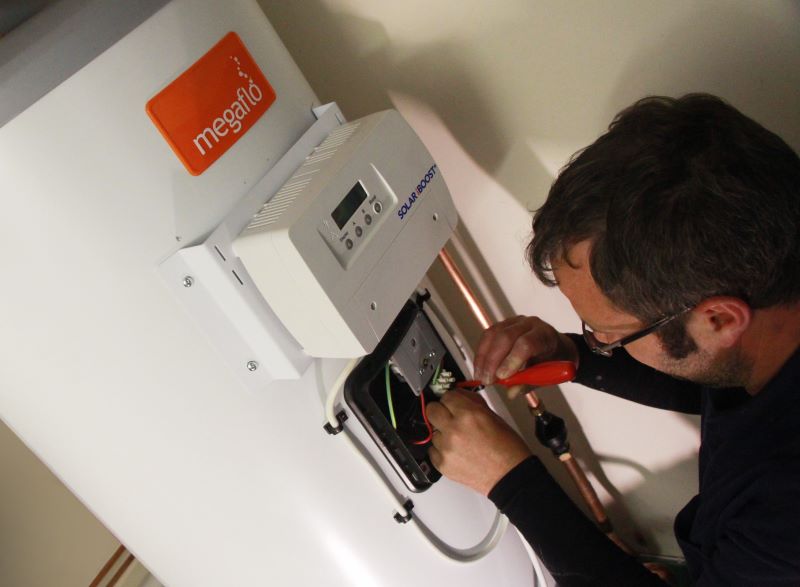
Raman Sohal, Product Manager for Residential & Commercial Cylinders at Baxi, explains how installers can raise the profile of hot water cylinders and ensure their customers’ cylinders continue to provide an efficient and reliable source of hot water.
It would be fair to say that hot water cylinders have taken a back seat over the years with the rising popularity of combi boilers. Consequently, fewer households have depended on cylinders as a component of their heating system and may either have forgotten or be completely unaware of their benefits.
But as heat pump demand continues to rise, cylinders are making a return as part of low-carbon heating solutions. This presents installers with a valuable opportunity to raise the portfolio of the hot water cylinders and educate their customers on the benefits of the products.
The attributes of hot water cylinders are straightforward and easy for installers to explain to their customers – especially when armed with relevant data and insight. Simply put, the cylinders play a vital role in larger properties predominately by ensuring a consistently powerful flow rate is provided to hot water outlets while supplying a standby provision of hot water.
So, when it comes to choosing a hot water cylinder, which factors do installers need to consider and how can this determine product choice?
Flow and recovery performance
Homeowners may benefit from understanding the factors that influence an installer’s choice of cylinder size for their property, especially when considering the current cost-of-living crisis. By equipping themselves with basic data, installers can offer the most suitable advice during property visits. This includes information such as the number of occupants, showers, and baths, as well as the likelihood of simultaneous usage. The Megaflo Eco 2 and Baxi cylinders, ranging from 70 to 300 litres, offer solutions for every installation.
Using this data in real-life situations can help installers communicate technical information effectively. For instance, an explanation of the hot water delivery rate in litres per minute and how this translates to the performance of a shower or the time to fill a bath can be particularly useful. A Baxi Indirect Cylinder, for example, can achieve a flow rate of up to 76 litres per minute, which is significant when a lower rate of just 22 litres per minute can fill a standard bath with hot water in just under five minutes.
For homes with high and frequent hot water demand, recovery times are a crucial consideration, which highlight the importance of the heat exchanger’s quality within the cylinder. Cylinders like the Megaflo Eco2 or Baxi Indirect Cylinder, are equipped with high-performance coil-in-coil heat exchangers, offer impressive recovery times. For instance, a 125-litre Megaflo Eco cylinder can recover 70% of its volume in just 30 minutes.
The insulation level of a hot water cylinder is another crucial factor for installers to consider, as it directly impacts efficiency and energy bills. By reminding customers that their hot water cylinder is retaining heat effectively throughout the day, installers can help them save energy and provide peace of mind.
Exploring electric
It’s certainly no secret that heat pump technology has grown to the fore as one of the most effective ways to decarbonise most properties. This in turn further emphasises the important role of the cylinder within a system. Any homeowner looking to make that transition from boiler to heat pump will need a way to store hot water for when they need it. This means they too will need to be made aware of just how key a well-designed air source heat pump cylinder is to their hot water performance.
While the baseline performance of the cylinder will always prove critical, the energy infrastructure of the home itself is growing in importance too. Trends show a rise in the number of homeowners wanting to be more environmentally friendly, save energy and increase their own energy security. This is where a combination of electrical solutions can really come into its own. In these instances, the use of solar pv panels in conjunction with a solar PV cylinder can minimise the need to draw electricity from the grid at peak times, thus contributing to lower running costs.
Championing servicing
It is crucial to emphasise the significance of regular servicing for hot water cylinders, just like with other heating solutions. This ensures safety and optimal performance. While boiler servicing is frequently promoted, it is equally important to remind homeowners about the need to service unvented cylinders too.
By maintaining a diligent approach to servicing, the risk of unexpected repair costs is minimised, and the cylinder remains safe for use. Like boilers, the longevity of a hot water cylinder and its warranty are often tied to regular servicing. Despite the misconception that servicing a cylinder is simple, regular maintenance as part of a service ensures safety measures are in place, providing peace of mind for customers while operating efficiently.
The three tiers of safety – control stat, T&P valve, and energy cut out – are crucial for maintaining high levels of performance and user safety. A basic servicing checklist includes inspection, strainer cleaning, descaling, expansion volume recharge, and re-commissioning. While the installation document contains detailed servicing instructions, discussing the importance of servicing with homeowners encourages regular maintenance.
Installers are now more than ever, viewed as trusted advisors for heating queries, offering guidance on energy consumption and other opportunities to maximise a system’s performance. This makes now the perfect time to raise the profile of hot water cylinders as a holistic answer to many homeowner heating quandaries.













